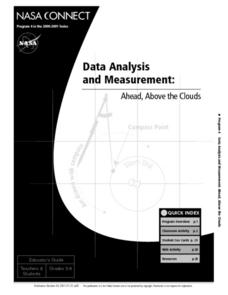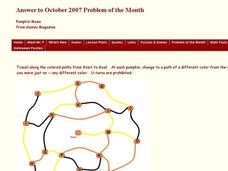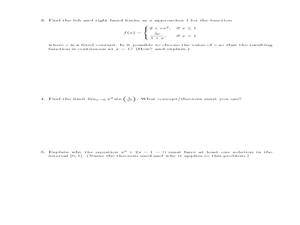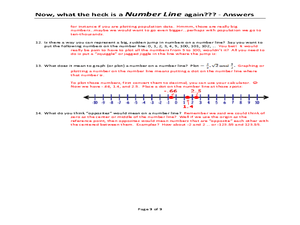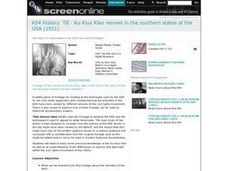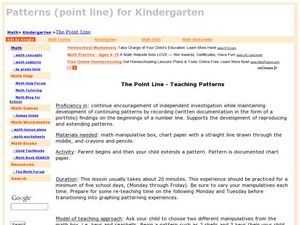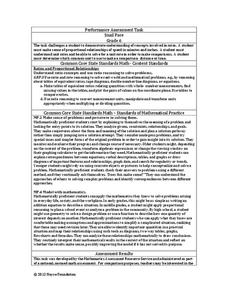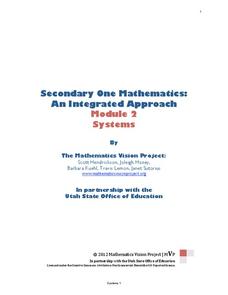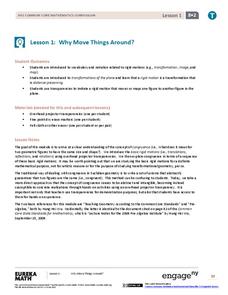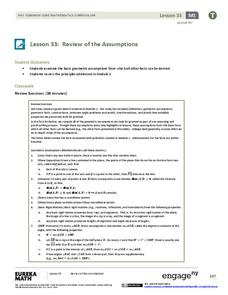Curated OER
Japanese Scientists Photograph Giant Squid
Students read and discuss a news article about scientists capturing first-ever photos of a giant squid in its habitat. They answer comprehension questions, write a journal entry from the scientists point of view, and analyze a giant...
Curated OER
Data Analysis and Measurement: Ahead, Above the Clouds
Students explore and discuss hurricanes, and examine how meteorologists, weather officers, and NASA researchers use measurement and data analysis to predict severe weather. They plot points on coordinate map, classify hurricanes...
Curated OER
Finding Science in An American Childhood by Annie Dillard
Students read excerpts from Annie Dillard's memoir, "An American Childhood," with the teacher. They experience opportunities to connect English, science, nature and art together from a new and unique perspective. This approach serves as...
Curated OER
Bronte and Rhys' Portrayal of Bertha
Young scholars, while reading and discussing the two texts by Charlotte Bronte and Jean Rhys, compare/contrast the two main characters and juxtapose them as the same character told from two different points of view. They gain insight of...
National Endowment for the Humanities
Colonizing the Bay
Eleventh graders review the goals of John Winthrop. In this American History lesson plan, 11th graders read Winthrop's speech and summarize his key points. Students predict the possibilities for success and failure in the...
Curated OER
Pumpkin Maze
For this algebra worksheet, students rewrite word problems using algebraic symbols. They discuss the changes they must make when they approach a certain color. There is an answer key.
Curated OER
Math 155 - Fall 2002 Worksheet 3: Continuity
In this continuity worksheet, students solve 5 short answer problems about continuity. Students determine where functions are continuous and find the limits of functions at points of discontinuity.
Curated OER
Now, what the heck is a NUMBER LINE again???
A unique approach to reviewing number lines and how to locate different values on them, this worksheet poses several questions that require written answers rather than calculations. You could use this as a note-taking guide when teaching...
Curated OER
Lewis and Clark and Native Americans, Part I
Students will identify the structure of the Dakota Nation including the Seven Council Fires, explore the relationship between the Corps of Discovery and the Lakota and examine the conflict between the two parties from varied points of view.
Curated OER
Role of Cerci in Escape Responses of the Cockroach
Students investigate the changes in escape behavior in Madagascar Hissing Cockroahes when their sensory apparatus is removed. They use puffs of air at differnt angles to simulate a predator's approach then collect and analyze data on...
Curated OER
Personal Resources
Students study taking care of themselves and their possessions. They develop a positive approach to life and a mature sense of self-worth and value. They discuss the importance of confidentiality in a class when sharing personal...
Curated OER
USA: the KKK and Civil Rights Movement
Students view film footage of the Ku Klux Klan in the U.S. in the early 1920s and examine how the actions of the KKK have been viewed by different strands of the civil rights movement. They watch the film and answer discussion...
Curated OER
Jack London's The Call of the Wild: "Nature Faker"?
Students take a stand on whether or not London could be dubbed a "nature faker." They support their position with evidence either historical or from the text. Students write an essay, complete with hypothesis and textual support, on...
Curated OER
The Point Line - Teaching Patterns
Students practice extending patterns. In this patterns lesson plan, students demonstrate extending patterns by performing a rhythmic patter.
Noyce Foundation
Snail Pace
Slow and steady wins the race? In the assessment task, scholars calculate the rates at which different snails travel in order to find the fastest snail. Hopefully, your class will move much more quickly in finishing the task!
Mathematics Vision Project
Module 2: Systems of Equations and Inequalities
The brother-sister pair Carlos and Clarita need your class's help in developing their new pet sitting business. Through a variety of scenarios and concerns presented to the siblings, the learners thoroughly explore systems of equations...
Maryland Department of Education
The Concept of Identity Lesson 5: Motivation - Maslow's Hierarchy of Needs
Maslow's Hierarchy of Needs provides the lens class members use to analyze and evaluate the motivations of the characters in Sylvia Plath's "Initiation" and scenes from Mean Girls. Readers then select a character from A...
EngageNY
Why Move Things Around?
Explore rigid motion transformations using transparency paper. Learners examine a series of figures and describe the transformations used to create the series. They then use transparency paper to verify their conclusions.
California Education Partners
Least and Greatest
Squares can be magic. Pupils use their knowledge of addition of positive and negative rational numbers to create a 3 X 3 magic square where the sums are 1. Scholars create addition and multiplication expressions with a set of rational...
California Education Partners
Miguel's Milkshakes
Moooove over, there's a better deal over there! The fourth segment in a series of eight requires individuals to determine the best unit cost for milk. Scholars calculate the least amount they can spend on a particular quantity of...
California Education Partners
Yum Yum Cereal
Design an efficient cereal box. Scholars use set volume criteria to design a cereal box by applying their knowledge of surface area to determine the cost to create the box. They then determine whether their designs will fit on...
Bowland
Public Transport
"Statistics is the grammar of science" -Karl Pearson. In the assessment task, learners read a claim made by a newspaper and analyze its conclusions. They need to think about the sample and the wording of the given statistics.
EngageNY
Definition of Reflection and Basic Properties
Discover the results of reflecting an image. Learners use transparency paper to manipulate an image using a reflection in this fourth lesson plan of 18. They finish by reflecting various images across both vertical and horizontal lines.
EngageNY
Review of the Assumptions (part 1)
What was the property again? Tired of hearing this from your pupils? Use this table to organize properties studied and as a reference tool for individuals. Learners apply each property in the third column of the table to ensure their...

